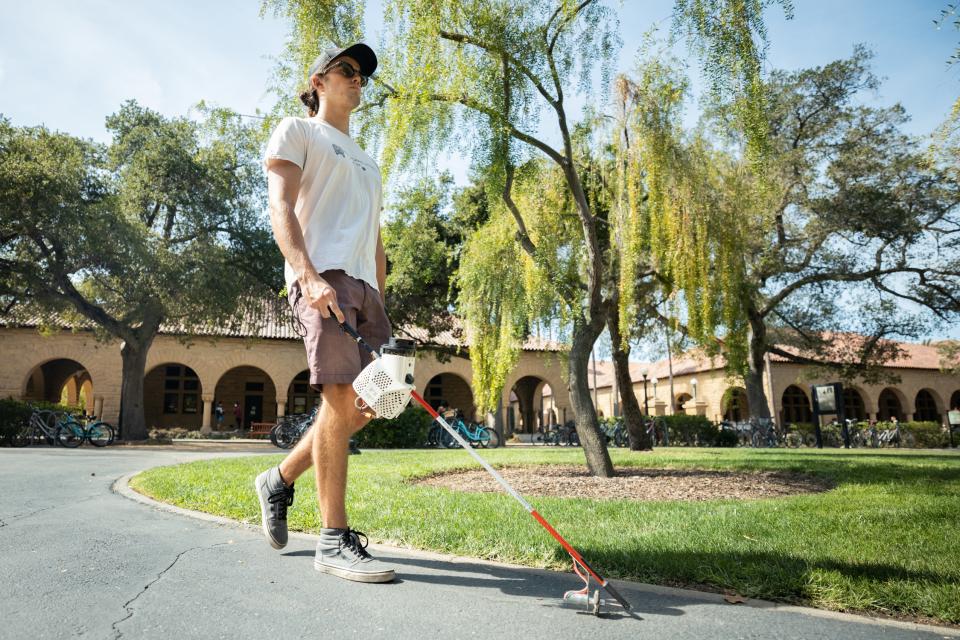
Stanford PhD candidate Michael John Raitor tests out the augmented cane, created with way-finding capabilities similar to those used in autonomous vehicles. | Andrew Brodhead
Most know the white cane as a simple-but-crucial tool that assists people with visual impairments in making their way through the world. Researchers at Stanford University have now introduced an affordable robotic cane that guides people with visual impairments safely and efficiently through their environments.
Using tools from autonomous vehicles, the research team has built the augmented cane, which helps people detect and identify obstacles, move easily around those objects, and follow routes both indoors and out.
The augmented cane is not the first smart cane. Research sensor canes can be heavy and expensive — weighing up to 50 pounds with a cost of around $6,000. Currently available sensor canes are technologically limited, only detecting objects right in front of the user. The augmented cane sports cutting-edge sensors, weighs only 3 pounds, can be built at home from off-the-shelf parts and free, open-source software, and costs $400.
Read the study: “Multimodal Sensing and Intuitive Steering Assistance Improve Navigation and Mobility for People with Impaired Vision”.
The researchers hope their device will be an affordable and useful option for the more than 250 million people with impaired vision worldwide.
“We wanted something more user-friendly than just a white cane with sensors,” says Patrick Slade, a graduate research assistant in the Stanford Intelligent Systems Laboratory and first author of a paper published in the journal Science Robotics describing the augmented cane. “Something that cannot only tell you there’s an object in your way, but tell you what that object is and then help you navigate around it.” The paper comes with a downloadable parts list and DIY solder-at-home instructions.
Borrowing from Autonomous Vehicle Technology
The augmented cane is equipped with a LIDAR sensor. LIDAR is the laser-based technology used in some self-driving cars and aircraft that measures the distance to nearby obstacles. The cane has additional sensors including GPS, accelerometers, magnetometers, and gyroscopes, like those on a smartphone, that monitor the user’s position, speed, direction, and so forth. The cane makes decisions using artificial intelligence-based way finding and robotics algorithms like simultaneous localization and mapping (SLAM) and visual servoing — steering the user toward an object in an image.
“Our lab is based out of the Department of Aeronautics and Astronautics, and it has been thrilling to take some of the concepts we have been exploring and apply them to assist people with blindness,” says Mykel Kochenderfer, an associate professor of aeronautics and astronautics and an expert in aircraft collision-avoidance systems, who is senior author on the study.
Mounted at the tip of the cane is the pièce de résistance — a motorized, omnidirectional wheel that maintains contact with the ground. This wheel leads the user with impaired vision by gently tugging and nudging, left and right, around impediments. Equipped with built-in GPS and mapping capabilities, the augmented cane can even guide its user to precise locations — like a favorite store in the mall or a local coffee shop.
In real-world tests with users that volunteered through the Palo Alto Vista Center for the Blind and Visually Impaired, the researchers put the augmented cane in the hands of people with visual impairments as well as sighted people who were blindfolded. They were then asked to complete everyday navigation challenges — walking hallways, avoiding obstacles, and traversing outdoor waypoints.
“We want the humans to be in control but provide them with the right level of gentle guidance to get them where they want to go as safely and efficiently as possible,” Kochenderfer says.
In that regard, the augmented cane excelled. It increased the walking speed for participants with impaired vision by roughly 20 percent over the white cane alone. For sighted people wearing blindfolds, the results were more impressive, increasing their speed by more than a third. An increased walking speed is related to better quality of life, Slade notes, so the hope is that the device could improve the quality of life of its users.
Opening Up Access
The scholars are open-sourcing every aspect of the project. “We wanted to optimize this project for ease of replication and cost. Anyone can go and download all the code, bill of materials, and electronic schematics, all for free,” Kochenderfer says.
“Solder it up at home. Run our code. It’s pretty cool,” Slade adds.
But Kochenderfer notes the cane is still a research prototype. “A lot of significant engineering and experiments are necessary before it is ready for everyday use,” he says, adding that he and the team would welcome partners in industry who could streamline the design and scale up production to make the augmented cane even more affordable.
Next steps for the team include refinements to their prototype and developing a model that uses an everyday smartphone as the processor, an advance that could improve functionality, broaden access to the technology, and further drive down costs.
Original Article: Stanford Researchers Build $400 Self-Navigating Smart Cane
More from: Stanford University
The Latest Updates from Bing News & Google News
Go deeper with Bing News on:
Smart cane
- Senior Yorkie's Idea of a Walk Is the Picture of Function and Fashionon May 7, 2024 at 7:48 pm
It’s a smart concept. Viewer @E remarked ... Viewer @bitterbean_ kidded, “I have a Cane Corso Lab mix. I wish I could do this with my baby. She’s five months and already 40-something pounds.” Nope, ...
- Raising Cane’s headed to UCF areaon May 7, 2024 at 10:16 am
A development plan review request filed in Orange County on May 3 is seeking permission to demolish the Del Taco drive-thru restaurant at 12025 Collegiate Way — near the intersection of University ...
- Where Sustainability And PC Monitor Design Collideon May 7, 2024 at 5:30 am
By demanding eco-conscious practices and endorsing environmentally responsible initiatives, business leaders become powerful catalysts for sustainable change.
- The Verge’s 2024 Mother’s Day gift guideon May 4, 2024 at 3:03 pm
There’s never a bad time to show appreciation for your mom, but Mother’s Day serves as an opportunity to go above and beyond for the person who birthed, bathed, and burped you. For many, brunch and ...
- Harford County sheriff says $1 million settlement in deadly shooting involving deputy was prematureon May 2, 2024 at 5:33 pm
Harford County leaders are paying a $1 million settlement to avoid a lawsuit in a 2022 deadly shooting involving a deputy.
Go deeper with Google Headlines on:
Smart cane
[google_news title=”” keyword=”smart cane” num_posts=”5″ blurb_length=”0″ show_thumb=”left”]
Go deeper with Bing News on:
Self-navigating smart cane
- Watch Waymo's Self-Driving Cars Navigate a Freewayon May 5, 2024 at 5:00 am
Those freeway rides are currently being tested with employees. Waymo gave CNET an exclusive peek of its cars on the (bigger) road, which you can check out in the video above. According to the company, ...
- The Verge’s 2024 Mother’s Day gift guideon May 4, 2024 at 3:03 pm
There’s never a bad time to show appreciation for your mom, but Mother’s Day serves as an opportunity to go above and beyond for the person who birthed, bathed, and burped you. For many, brunch and ...
- Navigating Job Loss: The Importance Of Mindset And Self-Careon May 1, 2024 at 4:00 am
However, amid the chaos, it's essential to remember the positive impact that mindset and self-care can have on our ability to navigate job loss successfully. Several years ago, I found myself ...
- A Smarter Caneon November 2, 2023 at 12:31 pm
He co-developed the WeWALK—a smart cane that detects objects above chest ... million visually impaired and blind people worldwide navigate a digital world without having to juggle a smartphone.
- What Are Smart Contracts on the Blockchain and How Do They Work?on December 12, 2022 at 9:57 pm
A smart contract is a self-executing program that automates the actions required in an agreement or contract. Once completed, the transactions are trackable and irreversible. The best way to ...
Go deeper with Google Headlines on:
Self-navigating smart cane
[google_news title=”” keyword=”self-navigating smart cane” num_posts=”5″ blurb_length=”0″ show_thumb=”left”]









